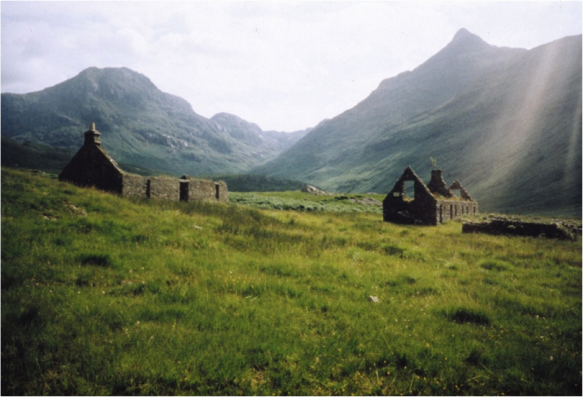I have just returned from my summer holiday, cycling along the coast of Norway from Kristiansand to Bergen; a beautiful part of the world, which strongly reminded me of many holidays spent in the NW Highlands and islands of Scotland. At least, I say that “it reminded me of Scotland”, less because of its similarity and more due to the fact that I kept on asking myself “Why is Norway so different from Scotland?!”
Of course, there are many similarities – of topography, geology, climate and traditional economies – which one might expect of two regions that are not too far apart, in the wet and temperate, Gulf Stream affected coastal highlands of the north Atlantic. But what struck me as more surprising was just how different the two regions were, particularly since the seemingly more luxuriant in flora and fauna (as well as perhaps the more populous) was the region lying further to the north: Norway. One might expect that the more northern region – more climatically inhospitable, wetter, more mountainous and more isolated – would be the tougher place to live, both for humans and for flora/fauna, but this doesn’t seem to be the case.
This isn’t the place to get into the politics of concerted massive regional State spending in a comparatively equal society (just yet!), but it struck me that there was something more going on in Norway, in terms of landscape and ‘natural’ heritage management, than it just being the product of the oil money bonanza. Put simply, while much of the NW Highlands and islands of Scotland are fairly bare of forest, Norway seemed to be almost entirely forested – and without the densely-packed plantations that seemed to be favoured by the old Forestry Commission in the UK.
These questions reminded me of a blogpost I write back in May 2017, about issues of afforestation and ‘rewilding’ in Scotland and on Dartmoor. But, while many ‘rewilding’ debates in the UK tend to revolve around the twin issues of sheep farming and deer stalking, cast as a sort of zero-sum game, coastal areas of Norway seem to have plenty of sheep (mostly with bells around their necks) as well as plenty of forest.

Typical forested coastline in Norway
While on our cycle tour, we stayed at a mix of ‘cheap’ (by Norwegian standards) hotels, hostels and campsite cabins, many of which had old photos on their walls; showing what their location looked like in the late 19th and early 20th century, before the Second World War, and before the oil bonanza. And the thing that immediately struck me was just how bare the landscapes were – these black and white photographs really did look just like Scotland. In Mandal, we stayed in a hostel that was once the town’s gaol. In their historical notes, I found a reference to how the gaol was planned to be built out of wood, but had to be built in brick due to the scarcity of timber in the region. Really?! … Norway ‘scarce of timber’?!
This was certainly a very different-looking landscape to what we were cycling through today. So, how did the paths of Norway and Scotland diverge so sharply in the later 20th century when it comes to forest cover?
On the face of it – following a few discussions with a professional forester, and some critical reflection on what I know, the following observations seem pertinent:
First: While both regions saw a general depopulation and experienced wholesale emigration in the early 20th century, the nature of this experience, together with the implications for landscape management were different. While it seems that land abandonment in Norway led to afforestation, the emptying of tenanted crofts in Scotland did not lead to a similar expansion of forests. This might be connected to differences of land ownership and tenure – with Scotland (in)famously divided up into huge estates owned by just a few hundred people, and Norway known for its small holding traditions. And/or I might be connected to the power and continued prominence of deer stalking in Scotland, which requires the wide open ‘empty’ spaces that you find in the Scottish Highlands.
Secondly, and connected: while walking and mountaineering pursuits seem to be popular in both regions, it struck us that forests were at the heart of expectations for walkers and backpackers in Norway – while the Scottish Mountaineering Council have (controversially) made a few strong statements about how the ‘empty spaces’ of the Scottish Highlands are what is expected.
Third: while George Monbiot and other rewilding enthusiasts seem to see sheep farming as a root of all evil, we saw a lot of ‘forest sheep’ in Norway. We presumed that the stocking levels and management systems of Norway must be different (?), but it suggests that sheep farming livelihoods and ‘Caledonian forestry’ can go hand-in-hand.
Lastly: we assumed that a wealthy State and strong regional policies were behind the apparent fertility and abundance of the Norwegian experience, but this has some interesting heritage paradoxes – that the experiences of so many marginalised and impoverished people in Norway can be largely forgotten and elided, partly due to the ‘success’ of contemporary landscape management. While we should cherish all that rich biodiversity, we should not forget that this resulted from abandonment and emigration – something that it is difficult to ignore in Scotland.

Remains of old settlement, Glen Carnoch, Knoydart. Difficult to ignore the human story behind this ’empty’ landscape








